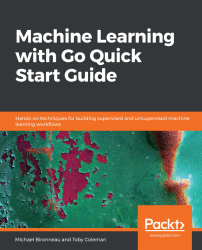- http://yann.lecun.com/exdb/lenet/. Retrieved March 24, 2019.
- https://blogs.nvidia.com/blog/2016/05/06/self-driving-cars-3/. Retrieved March 24, 2019.
- https://github.com/zalandoresearch/fashion-mnist. Retrieved March 24, 2019.
- http://colah.github.io/. Retrieved May 15, 2019.
- https://karpathy.github.io/. Retrieved May 15, 2019.
- http://www.dcc.fc.up.pt/~ltorgo/Regression/cal_housing.html. Retrieved March 24, 2019.

Machine Learning with Go Quick Start Guide
By :
Machine Learning with Go Quick Start Guide
By:
Overview of this book
Machine learning is an essential part of today's data-driven world and is extensively used across industries, including financial forecasting, robotics, and web technology. This book will teach you how to efficiently develop machine learning applications in Go.
The book starts with an introduction to machine learning and its development process, explaining the types of problems that it aims to solve and the solutions it offers. It then covers setting up a frictionless Go development environment, including running Go interactively with Jupyter notebooks. Finally, common data processing techniques are introduced.
The book then teaches the reader about supervised and unsupervised learning techniques through worked examples that include the implementation of evaluation metrics. These worked examples make use of the prominent open-source libraries GoML and Gonum.
The book also teaches readers how to load a pre-trained model and use it to make predictions. It then moves on to the operational side of running machine learning applications: deployment, Continuous Integration, and helpful advice for effective logging and monitoring.
At the end of the book, readers will learn how to set up a machine learning project for success, formulating realistic success criteria and accurately translating business requirements into technical ones.
Table of Contents (9 chapters)
Preface
 Free Chapter
Free Chapter
Introducing Machine Learning with Go
Setting Up the Development Environment
Supervised Learning
Unsupervised Learning
Using Pretrained Models
Deploying Machine Learning Applications
Conclusion - Successful ML Projects
Other Books You May Enjoy
Customer Reviews

